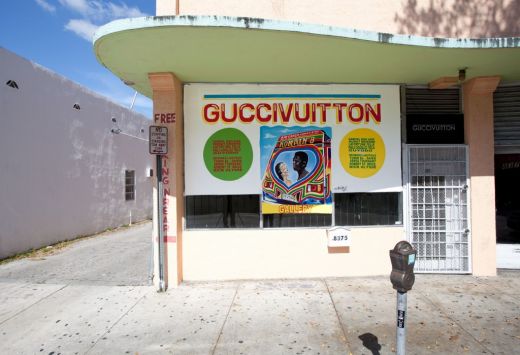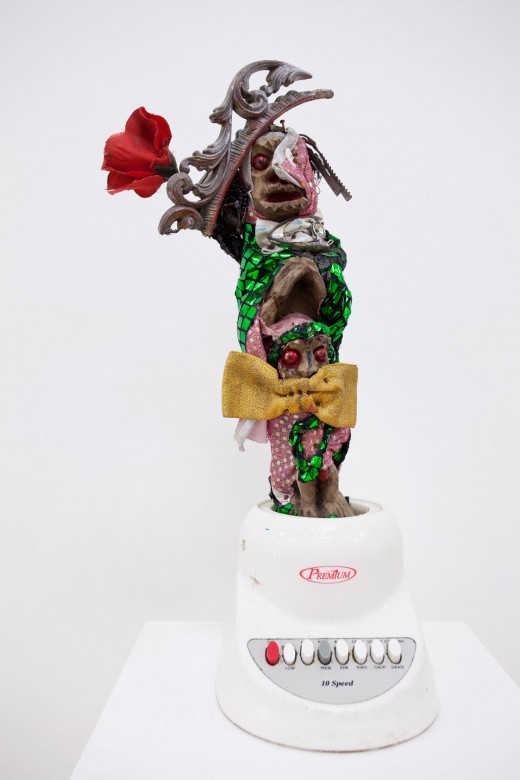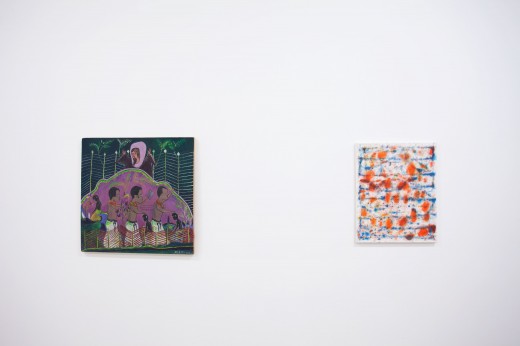The Look
Hunter Braithwaite

Serge Toissant's commissioned mural on the front of the gallery.
April 19 – May 31 2014
On the evening that I saw this exhibition, the spiritual and sonic vibrations of Haiti pulsed through the gallery, emanating not from the work on display—a pared down yet far-reaching multigenerational survey of Haitian art in a variety of contexts—but from the church next door. The Look is self-aware on many levels. The art simultaneously basks in and skirts the pale gaze. The gallery, which has been open on 83rd and Ne 2nd for a few years now, is also aware of its conspicuous presence in the neighborhood. To break down those white cube walls, they’ve commissioned a mural from Serge Toissant, the only Miami street artist I’d like to see more of, and hosted concerts and get-togethers over the exhibition’s run. Had they planned it, the chants coming through the wall would have been a nice touch.
The title of the exhibition refers to Charlotte Rampling, the star of the sex-tourism film Heading South. A group of women go to Haiti expecting one thing, and getting the unexpected. As such, the show is rooted in understanding how one is seen from the outside, and then playing into that, or complicating it. The show pairs Haitian masters with contemporary artists, all of whom are of Haitian descent, with the exception of Pablo Gonzalez-Trejo, a Cuban painter who provides a facile defaced portrait of Francois “Papa Doc” Duvalier. Interesting that while politics tremble through The Look, the one explicitly political piece is also the show’s only misstep.

One of Guyodo’s idols made out of scrap materials.

(L) Felix LaFortune, Oh, nom du Christ, 1980s. Oil on Board.
(R) Tomm El-Saeih, Pizza, 2014, Oil on Canvas.
The contemporary pieces approach the same history, yet do so in highly nimble and coded ways. Marrron et Masqué (identified in the press release as “a collective,” but suspiciously reminiscent of Adler Guerrier) collaged bits of French text regarding style and culture. Not only do these works approach how folk painting (Haitian or otherwise) is read by a frequently illiterate population, the pieces are obscured by clouds of aerosol spray paint, a potential nod both to atmospheric perspective and to industrialization. Tomm El-Saieh and Rick Ulysse are two artists born in Haiti (1984, 1983 respectively) and based in South Florida. El-Saeih ran a space a few years ago, and Ulysse is currently in residency at the Museum of Art Fort Lauderdale (he was, quite similarly, in residency at MOCA as part of their 2012 partnership with Airbnb, Trading Places II). Here, they align the meshes of contemporary abstract painting (reductive, casual) with Hatian painting (flat and floral, up front) to allow the viewer to peer through both. Which is basically what The Look is all about.










